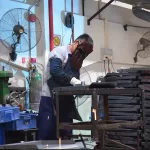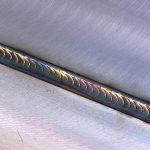To weld thin metal effectively, follow these guidelines: select the appropriate process (TIG or MIG with low amperage), utilize a smaller diameter wire or filler rod, and adjust the travel speed to prevent burn-through. Employ techniques like pulsing, stitch welding, or tack welds to manage heat, and allow cooling periods between welds to minimize warping.
Guide To Welding Thin Metal
Welding Town
Exploring Welding Thin Metal
While welding is commonly associated with joining massive metal sheets using powerful machines, it is also a valuable tool for working with thin and delicate pieces of metal. Whether you’re working in a factory that employs thin sheet metal or pursuing welding art at home, welding thin metal presents unique challenges. By adjusting welding angles, shielding gas, and other aspects of the welding process, these challenges can be overcome.
Why Is Welding Thin Metal Different?
Although welding is a versatile and universal technique, welding thin metals requires specific considerations. While thin metals share similarities with other metals, there are several reasons why welding thin metals differs from welding thicker substances. One significant factor is the sensitivity of thin metal to heat.
Welding involves melting the metal just enough to create a seam. With thin metals, there is a greater risk of melting the metal all the way through, resulting in burn-through, especially when lacking control over the welding machine’s heat. Achieving a delicate balance between adequate heat and avoiding excessive heat is a challenging task, particularly for beginners. Consequently, welding thinner metals such as aluminum proves more challenging than welding thicker materials.
Selecting the Best Welding Process for Thin Metals
Several welding methods are available, including MIG welding, TIG welding, and stick welding. Of these methods, MIG welding is the most suitable for welding thin metals. It is commonly used in manufacturing for welding sheet metals, which are thin pieces of metal. Additionally, MIG welding allows for pulsing, reducing the risk of burn-through.
While TIG welding was originally designed for thicker materials, it can also be used for welding thin metals. TIG welding provides greater precision and control over heat application, although it is more challenging for inexperienced welders.
Conversely, when working with very thin metals, it is advisable to avoid stick welding. This method offers less control over heat application, resulting in burn-through, splattering, and excessive slag formation.
Step-By-Step Guide To MIG Welding Thin Metals
| Metal Thickness (inches) | Recommended MIG Wire Size (inches) |
|---|---|
| 0.024 | 0.020 |
| 0.030 | 0.023 |
| 0.036 | 0.025 |
| 0.048 | 0.030 |
| 0.060 | 0.035 |
MIG welding is the most commonly employed technique for welding thin metals. The following steps outline the process:
- Select the Appropriate Shielding Gas
- MIG welding relies on shielding gas to prevent oxidation and affects the appearance of the weld bead. For thin metals, use shielding gases with high argon concentrations.
- Choose the Correct Filler Metal
- The filler metal melts into the weld, filling the gap between the two pieces. MIG welding automates the feeding process, simplifying the welder’s task. While the material of the filler metal is not critical, using thin wires is essential when working with delicate, thin sheet metal.
- Adjust the Torch Angle
- Adjusting the torch angle during MIG welding significantly reduces the likelihood of burn-through. Regardless of the welding position, ensure the angle shortens the distance between the tip and the metal. This stabilizes the arc, providing greater control over the weld and reducing the risk of burn-through.
- Consider Pulsing
- In addition to regular MIG welding, pulsing can be employed when welding thin metals. Pulsing involves heating a small portion of the plates to be joined, allowing the weld pool to solidify before filling in the joint. While mastering pulsing requires practice, it provides increased control over the energy output.
Step-By-Step Guide To TIG Welding Thin Metals
| Metal Thickness (inches) | Recommended TIG Amperage Range (amps) |
|---|---|
| 0.020 | 15-40 |
| 0.030 | 20-50 |
| 0.040 | 30-70 |
| 0.060 | 50-90 |
| 0.080 | 70-110 |
| 0.125 | 100-140 |
| Amperage | Tungsten Electrode Diameter (inches) |
|---|---|
| 1-20 | 0.020 |
| 15-80 | 0.040 |
| 50-100 | 1/16 |
| 80-130 | 3/32 |
Although TIG welding is typically used for thicker materials, it can be adapted for welding thin metals due to the superior control over energy output it offers. Follow these steps when TIG welding thin metals:
- Adjust the Amperage Settings
- The initial step in TIG welding thin metals involves adjusting the amperage settings. Lower the power setting and use smaller anodes to reduce energy output. Since thin metals require less energy to melt, this adjustment prevents burn-through. Take advantage of TIG welding’s foot pedal control to regulate heat during the welding process.
- Select the Appropriate Filler Metal and Apply It Correctly
- TIG welding employs tungsten anodes to create the arc. For thin metals, it is recommended to use 0.020 and 0.040 thoriated anodes. Thoriated tungsten, alloyed with thorium, provides enhanced current distribution for the anode.
- Maintain Even and Fast Heat Distribution
- When TIG welding thin metals, avoid concentrating heat in one area for an extended period. Utilize stitch welding, which involves applying a series of welds along a seam using a skip technique. This approach prevents excessive heat application in a single spot.
Employ a pulsing technique, stitch welding, or tack welds to manage heat and allow cooling periods between welds to minimize warping.
Welding Town
Final Thoughts
Welding thin metal presents challenges, as there is an increased risk of burn-through and damaging the base metal. To overcome these challenges, it is crucial to select a welding method that offers precise control, such as MIG or TIG welding. Additionally, ensure you have the appropriate electrodes and shielding gas while adjusting your technique accordingly.











